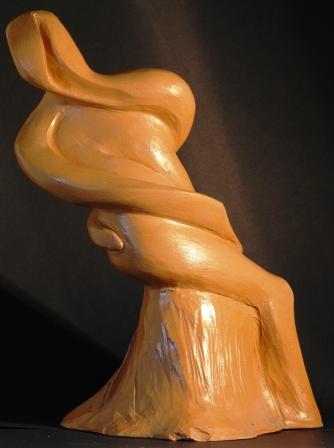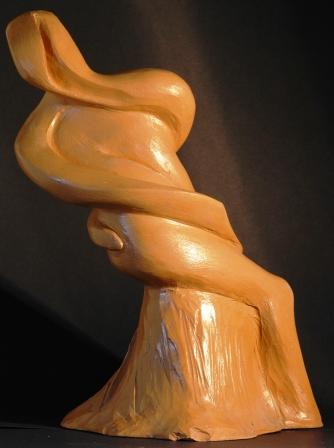
La scultura in terracotta raffigura un uomo accomodato su un tronco reciso che volgendosi indietro viene attratto dal turbine del proprio trascorso. Le tracce del vortice si evidenziano sul viso e sul corpo in mutamento.
L’opera, un “congegno-visivo”, invita lo spettatore a muoversi nel passato della propria vita e nel comune passato storico-sociale in modo da arricchire un presente sempre più immiserito culturalmente.
La scultura, che può definirsi autobiografica, riproduce l’uomo che osserva e medita sul proprio passato, e nel caso dell’Autore sulla propria fanciullezza vissuta con felice abbandono tra le montagne di Acerno, un paese immerso nel verde rigoglioso dei monti picentini.
L’opera rimanda ad una memoria lontana che si perde nei momenti e nei giorni trascorsi ad Acerno. L’artista ha voluto ripercorrere, nel profilo sinuoso della scultura, che pare rifare il contorno dei monti che circondano il paese, il proprio vissuto ritornando ai giorni gioiosi passati tra le viuzze e le mulattiere.
Un atto di ossequio a un luogo incantevole che negli ultimi anni sta vivendo una forte crisi culturale da cui non riesce ad affiorare.
Il colore caldo della terracotta ricorda il calore della sua terra.
Dialogando con l’artista, dell’opera e del suo contenuto, si percepisce subito l’orgoglio di chi rivendica con interesse la propria appartenenza culturale e sociale. La scultura è l”esaltazione di un passato che sembra non rivivere più nelle nuove generazioni, un passato fatto di giochi da strada che rafforzavano il vivere comune, passatempi dal gusto rinascimentale che ricordano quelli rappresentati da Pieter Bruegel il Vecchio nel quadro “Giochi infantili”, e che rinvigorivano antichi sentimenti di solidarietà, fratellanza, amicizia.
Sentimenti che in età adulta si sono poi mutati in personalismi ottusi, smarriti in una foresta di diversi impulsi tra loro conflagranti. L’innocenza di un bambino che crescendo si infrange in una esistenza multiforme in cui l’amicizia diventa invidia, la fratellanza diventa competizione demolitrice, la solidarietà egoismo.
Le pieghe della scultura, che conferiscono all’opera uno slancio proiettivo nel passato, diventano per l’autore dei ripari, dei luoghi di memoria e di meditazione in cui rifugiarsi nei momenti di rievocazione onirica. Simbolicamente vogliono ricordare quei valloni in cui da bambino si recava per cercare i funghi, i tartufi e la legna da ardere. Una scultura con una forte energia contemplativa che suggestiona l’osservatore, proiettandolo inevitabilmente nei pensieri più intimi della propria mente.
Man kidnapped from their past
The earthenware sculpture depicts a man sat on a stump cut that looking back is attracted by the whirlwind of his past. Traces of the vortex show on the face and body changing.
The work, a “device-visual,” invites the viewer to move into the past of his own life, and a common socio-historical past in order to enrich this increasingly culturally impoverished.
The sculpture, which can be called autobiographical, plays the man who observes and meditates on his past, and if the author’s own childhood living with happy abandon in the mountains of Acerno, a village surrounded by green Picentini.
The work refers to a distant memory that is lost in the moments and days spent in Acerno. The artist wanted to go back, sinuous profile of the sculpture, which seems to remake the contours of the mountains surrounding the country’s own experience going back to the joyful day passed through the narrow streets and paths.
An act of homage to a charming place that in recent years is having a strong cultural crisis which fails to emerge.
The warm color of the terracotta recalls the warmth of his homeland.
Dialogue with the artist, the work and its content, you immediately feel the pride of claims with interest their cultural or social. The sculpture is the exaltation of a past that seems more alive in new generations past in the street games that reinforced the common life, pastimes from the Renaissance style reminiscent of those represented by Pieter Bruegel the Elder in the painting “Childhood Games” and invigorate old feelings of solidarity, brotherhood, friendship.
Feelings in adulthood are then turned into dull personalities, lost in a forest forest of different pulses between their opposites
The innocence of a child growing up in a life is shattered when the friendship becomes multifaceted envy, competition becomes destructive brotherhood, solidarity selfishness.
The folds of the sculpture, which gives the work a projective momentum in the past, become the author of the shelters, places of memory and meditation to retreat to in times of dream recall. Symbolically, they want to remember those valleys in which a child was going to try mushrooms, truffles and firewood. A sculpture with a strong contemplative energy that impresses the viewer, projecting inevitably in the innermost thoughts of his mind.
